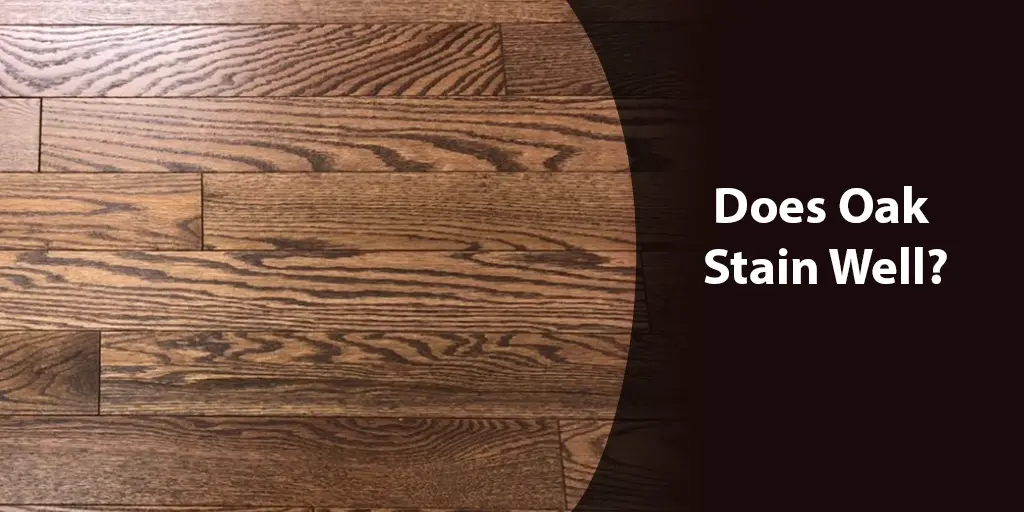Does Oak Stain Well? The Surprising Answer Woodworkers Have Known for Years
The short answer is: yes, oak stains beautifully due to its unique wood grain structure and porosity. But there’s more to the story of oak’s tremendous stainability that aspiring woodworkers may find surprising.

Packed with open pores and large cells, oak wood readily absorbs stain with a minimum of effort. Its grainy texture also helps distribute pigment evenly across the surface for a flawless finish.
These inherent qualities explain why oak has long been a go-to wood for woodworkers seeking lush, varied tones.
A lesser-known fact is that oak’s open-grained structure acts like millions of tiny sponges, soaking up stain without leaving unsightly blotches.
Its interlocking wood fibers wick pigment deep inside for intensely saturated colors. Even slight variations in oak’s grain patterns translate to richly nuanced hues after staining.
With proper preparation via sanding, cleaning, and using high-quality stains, oak delivers breathtaking results novice woodworkers can achieve with confidence. Just follow steps like these:
- Sand with progressively finer grits to 120/150 grit for a perfectly smooth surface
- Tack cloth to remove all dust before staining
- Apply stain generously along the grain with a brush or lint-free cloth
- Allow full drying time between additional coats (unless using gel stains)
Needless to say, oak’s legendary thirst for stain has kept it a perennial favorite of woodworkers for centuries. Its unbeatable combination of color-accepting properties, strength and longevity make oak a woodworking all-star in the eyes of professionals.
With a little know-how, you too can tap into oak’s unrivaled capacity for taking on rich, nuanced tones to wow customers and loved ones for years to come.
Characteristics that Make Oak Ideal for Staining
Oak’s inherent characteristics make it a woodworker’s dream for staining projects. Its highly absorbent nature stems from unique properties that promote flawless, nuanced finishes. Let’s take a closer look at what sets oak apart.
Open pores and large cells allow deep penetration of liquid stains inside the wood structure. Unlike denser species, oak’s porous cellular makeup soaks up pigments vigorously. This ensures richness and vibrancy instead of streaks.
Oak’s signature open-grained texture is arguably its biggest asset for staining. The gaps between strands act like perfect conduits rushing stain throughout.
Simultaneously, they break up the pigment’s flow for multitudinous undertones and natural variation.
Nature reinforced oak’s graininess with interlocking fibers that resist cracking or separation over time. This resilience protects stained finishes and ensures woodsaturated colors endure against weathering for decades of heirloom-quality beauty.
Its versatility in appearance belies oak’s hidden talents. Whether red or white oak, subtle grain nuances impact how specific stains react.
Woodworkers can choose colors to flatter each type’s natural tones. Multiple finished looks are possible from a single wood species.
With patience and diligence applying stain to oak, woodworkers unlock its potential. No other wood so eagerly takes on the deep, enchanting shades that elevate rustic character.
Oak’s unmatchable combination of engineering and aesthetics make it a staining artist’s prized medium.
Types of Oak and Their Stainability
While all oaks excel at taking stain, subtle variations between types affect outcomes. Knowledgeable woodworkers consider each species’ attributes to suit projects.
Red oak owes its name to hints of ruddiness in heartwood. Its texturally coarse, straight grain provides ample staining nooks. This openness yields chromatically enriched shades but also revealed warmth under some stains.
For unrestrained hues, red oak satisfies. Yet maintaining its inherent reddish notes, it requires stain selection diligence.
Contrastingly, white oak’s smoother, ripple-textured grain gives a staining Zen canvas. Hues emerge true to bottle with minimal ambient coloring. Its subtler grain pattern provides option to obscure identifying marks while maintaining character.
White oak’s water-resistance also recommends it for outdoor use, where it endures moisture gracefully without discoloring. Similarly, white oak withstands decades of interior UV without fading crafted stainwork.
Regardless of type, oakwood laboriously absorbs picked stain over days into each unique pattern woven through centuries.
With understanding, woodworkers consciously choose best flattering oak to highlight nature’s avant-garde artwork. Both species reliably ornament humble furnishings with nobility befitting stately halls.
With care in matching project and pigment to wood character, oak empowers woodworkers to craft meant-to-age art under any conditions.
Considerations for Selecting Stain for Oak
As with any relationship, finding the ideal stain match for oak requires carefully considering its inherent qualities.
Proper staining of oak is as much an art as science – chemistry and experience coming together. Here are the key factors that woodworkers rely on:
- The Grain: Oak’s trademark defining lines call out for a stain allowing their prominence. Light or dark, transparent or solid – choose what best elevates the grain’s beauty.
- Absorbency: Oak is thirsty stock made for deep saturation. Lighter stains may not deliver oak’s potential while darker versions could overwhelm its character. Experiment to optimize absorption.
- Undertones: From red oak’s warmer hints to white oak’s neutrality, respect oak’s natural tones lest stain clash. Complementary hues ensure a harmonious union.
- Sampling: Never fully commit to a relationship without testing compatibility first. Sample various stains on oak scraps to find the ideal objective and subjective match.
Making the right first impression also considers durability, finish and cost. Will the chosen stain defend oak through decades of use? Provide a hand-rubbed sheen or flat option? Fit the budget to avoid future regret?
With knowledge of oak qualities and openness to experiment, woodworkers source just the right supportive stain seasoning to fully bring out what’s naturally special in every partnership.
This prudent approach ensures installations that stand the test of pride and time.
What Kind of Stain to Use on Oak?
When selecting a staining formula for oak, the type of stain base requires weighing. Each offers unique perks, but understanding nuanced traits helps woodworkers pick the perfect match.
Oil-based stains have a solid reputation with oak handlers. Their non-water solvents penetrate deep for oak’s full saturation. Resulting hues pop vibrantly yet age gracefully as the wood darkens over years.
Purists argue oil stains best bring out oak character. However, their longer drying times and slight odor discourages some. Proper ventilation is a must for oil-based stain use.
As a green alternative, water-based stains have picked up steam. Their water solutions are safer and cleaner to employ. Advantages like quicker drying also speed multi-coat projects.
However, some note water-based stains don’t yield as rich color intensity on thirsty oak. Plus, raised grain can occur without due preparation. But for most jobs, with light sanding between, water stains do oak justice.
For meticulous patterns, viscous gel stains glide and level evenly. Their controllable application aids detail work but slower drying means lengthy span till sealing protection. Gel stain also provides fewer variable shades than oil or water stains.
With knowledge of each type’s nuanced traits, woodworkers pick the best stain formula match for any oak undertaking. Consider application ease, precise control and lasting finish benefits to ensure satisfying results.
Read Also: Does Wood Glue Work on Painted Wood?
Top Picks: Best Stain for Oak Wood
With oak’s porous nature beckoning rich saturation, woodworkers examine proven stain performers. Experience has identified standouts for crafting consistently breathtaking results time after time:
Minwax Pickle Oak illuminates oak’s natural characteristics subtly while imparting a barely-there greenish tinge. Ideal for minimalist modern interiors where oak’s innate beauty preaches without proselytizing.
Golden Pecan bathes oak in warm sun-kissed radiance evoking mid-century ambiance. Its Playboy mansion quality never grows trite, always setting a seductive mood perfect for entertainment spaces.
For period authenticity, Dark Walnut plunges oak into historical solemnity recalling centuries past. Reverently serious yet never severe, this stain makes a statement while keeping users grounded.
Jacobean transports oak to Tudor England with its aged rusticity. Stories are told and wine spilled as this rich emotion dye fosters fellowship and familiarity in any gathering place.
Simply White strips oak down to revolutionary GOPIC simplicity letting the woodworms run naked and free. Its pared-back minimalism maximizes grain grandeur without distracting from nature’s artistry.
Whether brightening a kitchen or oaken nook, Golden Oak Instills cheer and goodwill. Uplifting yet never saccharine, it lifts spirits daily with optimism’s light touch.
From libraries to lounges, these top performers permanentlydate and define spaces while impeccably showcasing oak’s eternally captivating character. Woodworkers find trusted allies in these legendary staining legends.
Does Oak Benefit from Wood Conditioner?
The porous nature enabling oak’s superior stain reception can also invite minor inconsistencies without pre-treatment. Experienced woodworkers debate conditioner’s true necessity, but most agree on its positive role with judicious use.
Conditioners work to refine the wood’s surface by penetrating the grain and filling surface pores to promote even saturation. With oak’s open grain hungry to drink deep of stain shades, proper preparation reinforces consistency.
However, too much conditioner can impede pigment penetration, compromising the wood’s design capabilities. As with any project, achieving balance is key. Light brushing delicate as dawn serves to refine without restraint.
When strain application proves a challenge on particularly porous samples, conditioner can smooth the way – not by filling the grain, but tempering its thirst, much like softening water enables steady dishwashing. More robust coats then flow on with grace.
As with stained oak itself, conditioner Barbados the duties of stress-removing and evening the working field while letting the innate wood beauty sing forth unencumbered.
Experts agree that for demanding projects conditioning is an investment generously repaid in perfectionist outcomes.
Duration, steady coverage and quick removal form the rituals of restraint permitting oak nature’sstage-crafted magnificence to command center area rug in allits richly variegated nuances. Properly introduced, conditioner bows out to let oak take unrivaled expression.
Tools and Materials for Staining Oak
Achieving the consistency required of fine oak staining demands the right equipment. Experienced woodworkers keep proven gear primed for impeccable jobs:
High-grit sandpaper wraps like velvet ensure buttery-smooth surfaces. Gradual progression from 100 to 220 leaves oak hungry to soak up every drop of dye.
Several natural-bristle brushes hold each coat with delicate caressing. Tapered sash and round brushes gently guide liquids where wood demands.
Bacon cloths smooth on, wipe away excess with sponge-soft caresses. Their long-staple cotton strands hug curves without lint or scratches to mar the finish.
Paint trays’ sloped sides deliver economical, controlled application while containing spills. Air tight lids keep delicate oil stains fresh until ready for reuse.
Stain conditioner evens the field for receptiveness. Conditioners smooth pores for continuous coverage of glistening pigments.
Protective topcoats seal in each piece’s stained charms from fingerprints to spills. Polyurethane guardians preserve woodland shades for decades of admiration.
Outfitted with necessities to complement oak’s innate splendor, woodworkers craft with steady hand and unwavering confidence.
Their gear becomes hand extended, instruments of art elevating nature to new brilliance through passion-perfected technique.
A Masterclass in Mastery: How to Stain Oak
With foundation laid, it’s time to walk through staining oak step-by-careful-step. By practicing these rituals, woodworkers attain meditative transformation of nature’s art:
Clean and sand – Scour off dirt and machine marks. Sand with grain from 120-220 grit to lustrous smoothness.
Condition (optionally) – Wipe on pre-stain lightly. Let set 5-10 minutes before wiping excess away. This equalizes absorption.
Apply stain – Use natural bristle brush to coat generously with grain. Allow to absorb 3-5 minutes. Wipe off surplus for even coverage.
Let dry – Times vary by product – from hours to days. Resist handling until bond has fully strengthened.
Inspect – Check for missed spots and evenness under lighting. Touch up thinly as needed.
Additional coats – Two or three passes may be required for deeper shades. Re-sand lightly between each with 220 grit to expose fresh wood.
Protect – Once color is set and dry, apply topcoat of polyurethane or tung oil. Buff to satin sheen with 0000 steel wool or automotive polish.
With dedicated attention like these ritualistic steps, oak happily surrenders to woodworker’s transformative touch.
Through repetitive honing, their brush becomes magic wand coaxing forth woodland’s inherent magnificence. Seasoned talent makes art seem effortless – but mastery’s reward lies in journey, not arrival alone.



